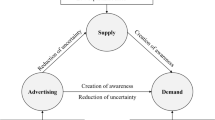Abstract
In this paper, we empirically analyze the French print media market by modeling the existence of a reciprocal effect between the size of the readership and the amount of advertising. For this two-sided platform, we measure the cross-effects of advertising on the readership and periodical popularity on advertising. By estimating a structural model of simultaneous demand equations, we quantify some crucial elements in designing pricing and product-differentiating strategies. We measure the impact of advertising on reader demand and find in the data that it has opposite effects depending on whether the publication presents informational or entertaining content. By taking into account the market interactions, we compute price and advertising elasticities. Our results show that advertisers targeting a specific category of the audience would choose its corresponding periodicals and would trade off the size of the readership for these periodicals and the advertising insert price changes. Also, advertising campaigns aimed at reaching a broader spectrum of the population should focus on popular titles and on titles for which demand is inelastic to ensure a more consistent impact of the campaign. Finally, for magazines with low price demand elasticity on the readers’ side, editors’ revenues could be improved by increasing prices. These combined effects should allow a publisher to generate positive margins from both sides of the market, for certain content categories.


Similar content being viewed by others
Notes
These annual data are then averaged at the issue level to better translate customers’ and advertisers’ behavior, as presented in the model section. For subscription fees to match cover prices, we divide the available annual subscription fee by the number of annual issues.
Alternative classifications were tested but brought meaningless results.
Note that similarly, around 75% of readers in France read no more than one newspaper or one magazine daily, according to an AudiPresse study (2014).
Time subscripts have been omitted for simplicity of exposure and without loss of generality.
Note that the “News” category includes both newspapers and news magazines, making the effect of content unmistakably different from an effect of format or color of the publications.
Remaining frequencies are daily, weekly, and three times weekly.
On top of tackling the standard price endogeneity issue, using an instrumental variable estimation here allows us to identify the reciprocal demand variations that are due to the demand changes on the other side of the market and that can be distinguished from the outcomes of demand-price mechanisms. Indeed, our instruments which include the lag of average prices of competing titles capture price adjustments resulting from competitive pressure.
Note that these parameters are not constrained in the estimation.
Note that a similar model capturing only the effect of readership on advertising demand, which is often studied in the literature, leads to poor statistical quality of estimation on our sample.
Elasticity measures per periodical are available upon request.
Available upon request.
Even if a fading effect of advertising on readership is expected as the number of advertising pages grows in an issue, this is not observed in our dataset because of the regulation on the number of advertising pages. The linear relationship between these variables here is then appropriate.
References
Argentesi, E., & Filistrucchi, L. (2007). Estimating market power in a two-sided market: the case of newspapers. Journal of Applied Econometrics, 22(7), 1247–1266.
Argentesi, E., & Ivaldi, M. (2005). Market definition in printed media industry: theory and practice. IDEI Working Paper, n. 376.
Armstrong, M. (2006). Competition in two-sided markets. The Rand Journal of Economics, 37(3), 668–691.
Berry, S. T. (1994). Estimating discrete-choice models of product differentiation. The Rand Journal of Economics, 25, 242–262.
Caillaud, B., & Jullien, B. (2003). Chicken & egg: Competition among intermediation service providers. RAND Journal of Economics, 34, 309–328.
Depken II, C. A., & Wilson, D. P. (2004). Is advertising a good or a bad? Evidence from US magazine subscriptions. The Journal of Business, 77(S2), S61–S80.
Filistrucchi, L., Klein, T. J., & Michielsen, T. O. (2012). Assessing unilateral merger effects in a two-sided market: an application to the Dutch daily newspaper market. Journal of Competition Law and Economics, 8(2), 297–329.
Godes, D., Ofek, E., & Sarvary, M. (2009). Content vs. advertising: the impact of competition on media firm strategy. Marketing Science, 28(1), 20–35.
Grigolon, L., & Verboven, F. (2014). Nested logit or random coefficients logit? A comparison of alternative discrete choice models of product differentiation. The Review of Economics and Statistics, 96(5), 916–935.
Ivaldi, M., & Verboven, F. (2005). Quantifying the effects from horizontal mergers in European competition policy. International Journal of Industrial Organization, 23(9), 669–691.
Ivaldi, M., & Zhang, J. (2017). Advertising competition in the free-to-air TV broadcasting industry. TSE Working Paper.
Kaiser, U., & Song, M. (2009). Do media consumers really dislike advertising? An empirical assessment of the role of advertising in print media markets. International Journal of Industrial Organization, 27(2), 292–301.
Kaiser, U., & Wright, J. (2006). Price structure in two-sided markets: evidence from the magazine industry. International Journal of Industrial Organization, 24(1), 1–28.
Rochet, J. C., & Tirole, J. (2003). Platform competition in two-sided markets. Journal of the European Economic Association, 1(4), 990–1029.
Rochet, J. C., & Tirole, J. (2005). Competition policy in two-sided markets. Advances in the Economics of Competition Law, MIT Press, Cambridge.
Sriram, S., Manchanda, P., Bravo, M. E., Chu, J., Ma, L., Song, M., Shriver, S., & Subramanian, U. (2015). Platforms: a multiplicity of research opportunities. Marketing Letters, 26(2), 141–152.
Acknowledgements
We thank Le Groupe La Poste for providing us with the data and their generous help in using them. We are grateful for the invaluable comments of François Boldron, Claire Borsenberger, Denis Joram, and Bernard Roy from the Department of Regulation, Institutional and European Affairs at Le Groupe La Poste and our colleague Sylvain Bourjade. The views presented here are those of the authors and do not necessarily represent the views of Le Groupe La Poste. All errors are our own.
Author information
Authors and Affiliations
Corresponding author
Rights and permissions
About this article
Cite this article
Ivaldi, M., Muller-Vibes, C. The differentiated effect of advertising on readership: evidence from a two-sided market approach. Mark Lett 29, 363–376 (2018). https://doi.org/10.1007/s11002-018-9464-7
Published:
Issue Date:
DOI: https://doi.org/10.1007/s11002-018-9464-7




